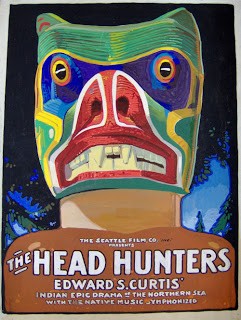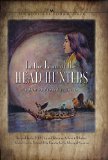| Reviews & Columns |
|
Reviews DVD TV on DVD Blu-ray 4K UHD International DVDs In Theaters Reviews by Studio Video Games Features Collector Series DVDs Easter Egg Database Interviews DVD Talk Radio Feature Articles Columns Anime Talk DVD Savant Horror DVDs The M.O.D. Squad Art House HD Talk Silent DVD
|
DVD Talk Forum |
|
|
| Resources |
|
DVD Price Search Customer Service #'s RCE Info Links |
|
Columns
|
|
|
In the Land of the Head Hunters / In the Land of the War Canoes
It was the first movie to feature an all-Native North American cast, and is the oldest feature film made in Canada known to survive. (However, those who made it, working for The Seattle Film Company, were primarily from the U.S., including Wisconsin-born Curtis.) And it was made eight years before Robert Flaherty's landmark Nanook of the North, much more clearly a documentary though likewise staged and editorially manipulated.
That Head Hunters survives at all is nothing short of miraculous. In the Land of the Head Hunters was, literally, rescued from a Dumpster by a film collector named Hugo Zeiter. In 1947 it was donated to the Field Museum of Natural History in Chicago, and together with the UCLA Film & Television Archive, this battered, decomposing, and incomplete print was combined with other bits rescued from the only other known surviving film element.
Milestone Film & Video's new two-disc Blu-ray debuts a reconstruction of the film, restoring the original color tinting as well as John J. Braham's original score. This release chokes with extra features, including In the Land of the War Canoes, a much less complete 1973 version of the picture presented by Bill Holm and George Quimby (and featuring a score performed by Kwakwakka'wakw musicians). Featurettes about the restoration process and the native peoples depicted in the movie are also included.
In the Land of the Head Hunters is basically a melodrama incorporating documentary aspects. Its story is interesting all by itself, but the movie gives equal weight to its visually supplemented travelogue-like lecture aspects. The 66-minute film follows Motana (Stanley Hunt), son of the great chief Kenada (Paddy ‘Malid), proving his manhood by visiting the Island of the Dead, and hunting and slaying both a sea lion and whale. (The latter is large enough for a man to crawl inside it through its mouth.) All the while Motana dreams of Naida (Sarah Constance Smith Hunt*), daughter of the chief of another tribe. In a fine effect worthy of Griffith, he sees her image in a cloud of campfire smoke.
However, tribal Sorcerer (Kwagwanu), aided by his powerful warrior brother, Yaklus (Balusta), also loves Naida, and this conflict prompts several extremely impressive battle scenes of warriors aboard 10- to 20-man battle canoes, in what press materials describe as "the Indian Trojan war." There's also a fascinating, colorful wedding ceremony about midway through the film, just before a break between the film's two acts.
Large portions of In the Land of the Head Hunters remain lost. Portions of the film are decomposed to the point where there's little more to see beyond tinted, abstract blotches, like something out of one of Norman McLaren's NFB shorts, or maybe a psychedelic poster. In other scenes the damage takes the form of something like a radioactive glow. In one key scene, an entire village (structures built by the Kwakwakka'wakw specifically for the movie) is set aflame just as the film itself becomes overwhelmed with decomposition. Some footage, such as the killing and aftereffects of the sea lion and whale hunts, may have been lost due to regional censorship issues.
In place of the missing or too-damaged scenes, UCLA's restoration team has substituted stills, while all of the original inter-titles have been recreated. Between the recreated titles and the use of stills, probably less than two-thirds of the original work remains, and even that is pretty battered most of the time.
Nonetheless, In the Land of the Head Hunters is a very rewarding viewing experience. Watching it, I was reminded of a huge collection of early 20th century Underwood & Underwood stereoscopic (3-D) photographs my grandfather had given me, many of them images similarly recording the practices of primitive peoples from around the world, images that captivated middle-class Americans who rarely ventured more than 20 miles from home.
The wedding feast is full of colorful gift-giving and elaborately costumed dancers dressed as various animals (a grizzly bear, a wolf, a mountain goat, etc.). They wear the skins (or feathers) of these animals along with extremely impressive hand-carved wooden masks. When aboard their war canoes, these same people dress up and stand fearsomely at the bow of each craft, clearly to intimidate their enemies.
Filmed near Tsaxis (Fort Rupert) in British Columbia, the magnificent, unspoiled scenery is eclipsed by the native peoples and their endlessly fascinating faces, dress, structures, dances, rituals, etc. Many of these tribal practices had been banned under Canada's anti-Potlatch laws (legislation not reversed until the early 1950s) but revived explicitly for the film. This proved a win-win for the Native Americans who were not only paid to work and appear in the movie, but who through the project were given the chance to revive and capture on film then-illegal rituals and customs. Today, only 5,500 or so Kwakwakka'wakw survive, and fewer than 5% speak the native language. Most, apparently, regard In the Land of the Head Hunters as an invaluable record of their nearly lost culture.
Video & Audio
In the Land of the Head Hunters is presented in its original 1.33:1 aspect ratio. Considering its age and obscure independent production origins, the surviving film elements looks fairly good. Scattered shots really help the picture come to life, while others are severely damaged, but enough of the original film survives, along with Braham's excellent score, to keep the viewer fully engaged. The alternate version, In the Land of the War Canoes, running 44 minutes, is visually less pleasing but the action is less interrupted by substituting stills, and interesting on its own for its use of Kwakwakka'wakw music, offered with optional English subtitles.
Extra Features
The many supplements include: an audio commentary with Bill Holm, Andy Everson, and Aaron Glass; a 40-minute featurette about the film's reconstruction; a Cultural Presentation by the Gwa'wina Dancers running nearly 90 minutes; a 16-minute making-of documentary, The Image Maker and the Indians, from 1979; a short featurette about the film's score; and a still gallery.
Parting Thoughts
Milestone's In the Land of the Head Hunters crystalizes the Blu-ray format's potential in terms of preserving and presenting long-lost obscure but culturally profound works, and a clear DVD Talk Collector Series title.
* Two other non-professional performers, Maggie Frank and Mrs. George Walkus, also play Naida in some scenes.
Stuart Galbraith IV is the Kyoto-based film historian and publisher-editor of World Cinema Paradise. His credits include film history books, DVD and Blu-ray audio commentaries and special features.
|
| Popular Reviews |
| Sponsored Links |
|
|
| Sponsored Links |
|
|
| Release List | Reviews | Shop | Newsletter | Forum | DVD Giveaways | Blu-Ray | Advertise |
|
Copyright 2024 DVDTalk.com All Rights Reserved. Legal Info, Privacy Policy, Terms of Use,
Manage Preferences,
Your Privacy Choices | |||||||














